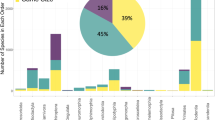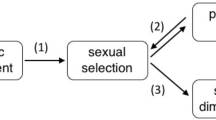Abstract
The females of many species of primates settle for life within the home ranges of their mothers, whereas males disperse as immatures1. According to the theory of sex allocation, the costs incurred by mothers through local competition for resources with their philopatric daughters should favour the evolution of male-biased sex ratios at birth2,3. I report here two tests of this hypothesis based on data from 15 genera of primates. First, I show that the intensity of competition for resources within kin groups is strongly and positively correlated with sex ratios at birth. Second, I show that sex ratios at birth are higher in genera with female-biased philopatry than in genera in which philopatry is not female-biased. These analyses suggest that local resource competition among kin powerfully influences the evolution of sex ratios in primates.
This is a preview of subscription content, access via your institution
Access options
Subscribe to this journal
Receive 51 print issues and online access
$199.00 per year
only $3.90 per issue
Buy this article
- Purchase on Springer Link
- Instant access to full article PDF
Prices may be subject to local taxes which are calculated during checkout
Similar content being viewed by others
References
Pusey, A. E. & Packer, C. in Primate Societies (eds Smuts, B. et al.) 250–266 (University of Chicago Press, 1987).
Bulmer, M. G. Heredity 56, 69–73 (1986).
Clark, A. B. Science 20, 163–165 (1978).
Silk, J. B. in Primate Societies (eds Smuts, B. et al.) 318–329 (University of Chicago Press, 1987).
van Schaick, C. P. Behaviour 87, 120–144 (1983).
Janson, C. Behav. Ecol. Sociobiol. 18, 125–138 (1985).
Climon-Brock, T. H. & Harvey, P. H. J. Zool., Lond. 183, 1–39 (1977).
Harvey, P. H. & Clutton-Brock, T. H. Evolution 39, 559–581 (1985).
Harvey, P. H. & Mace, G. M. in Current Problems in Sociobiology (ed. King's College Sociobiology Group) 343–362 (Cambridge Univ. Press, U.K., 1982).
MacFarland Symington, M. Behav. Ecol. Sociobiol. 20, 421–426 (1987).
Dobson, A. J. An Introduction to Statistical Modelling (Chapman and Hall, London, 1983).
Clutton-Brock, T. H., Albon, S. D. & Guiness, F. E. Nature 313, 131–133 (1985).
Fisher, R. A. The Genetical Theory of Natural Selection (Clarendon, Oxford, 1930).
Clutton-Brock, T. H. & Albon, S. D. in Current Problems in Sociobiology (ed. King's College Sociobiology Group) 223–248 (Cambridge University Press, 1982).
Damuth, J. Biol. J. Linn. Soc. 15, 185–193 (1981).
Clutton-Brock, T. H., Guiness, F. E. & Albon, S. D. Red Deer: Behaviour and Ecology of Two Sexes (Cambridge University Press, 1982).
Cockburn, A., Scott, M. P. & Dickman, C. R. Oecologia 66, 427–429 (1985).
Johnson, C. N. Behav. Ecol. Sociobiol. 19, 143–150 (1986).
Smuts, B. et al. Primate Societies III-III (University of Chicago Press, 1987).
Author information
Authors and Affiliations
Rights and permissions
About this article
Cite this article
Johnson, C. Dispersal and the sex ratio at birth in primates. Nature 332, 726–728 (1988). https://doi.org/10.1038/332726a0
Received:
Accepted:
Issue Date:
DOI: https://doi.org/10.1038/332726a0
This article is cited by
-
The global male-bias in sex ratio at birth is sustained by the sex ratio genotypes of replacement offspring
Genetica (2019)
-
Weaned age variation in the Virunga mountain gorillas (Gorilla beringei beringei): influential factors
Behavioral Ecology and Sociobiology (2016)
-
Proximate and ultimate explanations of mammalian sex allocation in a marsupial model
Behavioral Ecology and Sociobiology (2014)
-
Predicting primate responses to “Stochastic” demographic events
Primates (1999)
-
Extreme adaptive modification in sex ratio of the Seychelles warbler's eggs
Nature (1997)
Comments
By submitting a comment you agree to abide by our Terms and Community Guidelines. If you find something abusive or that does not comply with our terms or guidelines please flag it as inappropriate.



